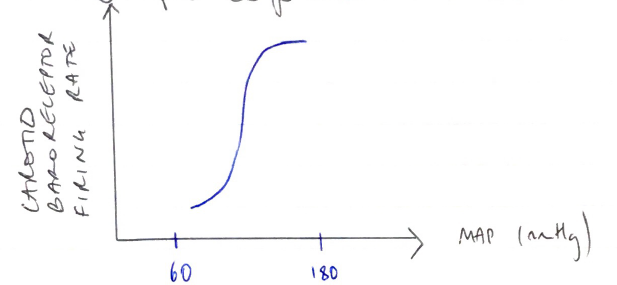G4iv / 14B16: Describe the baroreceptors & their role in the control of blood pressure
14B16: Exam Report
Describe the baroreceptors & their role in the control of blood pressure.
62% of candidates passed this question.
This is a core topic and a detailed knowledge was expected. Baroreceptors are stretch receptors located in the walls of the heart and blood vessels and are important in the short term control of blood pressure. Those in the carotid sinus and aortic arch monitor the arterial circulation. Others, the cardiopulmonary baroreceptors, are located in the walls of the right and left atria, the pulmonary veins and the pulmonary circulation. They are all stimulated by distention and discharge at an increased rate when the pressure in these structures rises. Better answers provided some detail on the innervation for these receptors. It was expected candidates would describe that increased baroreceptor discharge inhibits the tonic discharge of sympathetic
nerves and excites the vagal innervation of the heart. This results in vasodilation, venodilation, a drop in blood pressure, bradycardia and a decreased cardiac output.
Some candidates had a major misunderstanding around the purpose of “low pressure baroreceptors” with many believing that these are the ones that respond to lower blood pressures, while the “high pressure baroreceptors” respond to higher blood pressures.
G4iv / 14B16: Describe the baroreceptors & their role in the control of blood pressure
Definition
BP = the pressure in the arterial system = CO x SVR
- Important because it allows a pressure gradient to ensure organ blood flow
- It is the 1° measured variable in the reflex control of BP
- Monitored by BARORECEPTORS
- Controlled by a NEGATIVE FEEDBACK SYSTEM
Baroreceptors
- Splay type nerve endings
- Stretch receptors in the walls (adventia) of blood vessels & heart
- 2 types:
- HIGH PRESSURE → acute control of BP
2. LOW PRESSURE → regulate blood volume
High Pressure Receptors
- Short term BP regulation
Sensors
- Carotid Sinus (Dominant, MAP 60 – 180mmHg)
- Aortic Arch (higher threshold, secondary receptors)
- Detect wall stretch
- ↑detection for faster rate of ∆pressure

- Transmit impulses via:
- Sinus → Glossopharyngeal (IX) → NTS
- Aortic Arch → Vagus (X) → NTS
- Transmit impulses via:
Control
- Vasomotor & cardiac centres of Medulla
- NTS stimulated
- Projects inhibitory neurons to RVLM ∴↓ output
- Excites neurons of DORSAL VAGAL NUCLEUS & NUCLEUS AMBIGUUS
Effectors
- ANS by negative feedback
- ↓BP → ↑ & ↓parasympathetic ouput
- ↑BP → ↓symp. & ↑parasympathetic output
ie ↑BP → ↓symp. & ↑parasympathetic output
@Heart
- ↓HR
- ↓FOC
- ↓SV
→ Restore BP
@Vessels
- Veno & arteriolar dilatation
- ↓PreL
- ↓Venous return
- ↓CO
→ Restore BP
NB: arterial BaroR can be reset for higher/lower BPs i.e. HTN, exercise
Low Pressure Receptors
- Aka ‘Volume Receptors’ → long term management of BP
Sensors
- Walls of atria, vessels & Great veins
- Detect ↑stretch due to volume overload
- MYELINATED VAGAL AFFERENTS
Control
- CV centre of Medulla → info transmitted to NTS
Effectors (Negative Feedback i.e.↑BP)
- ↓ADH → promote diuresis
→ Restore BP
- Author: Krisoula Zahariou